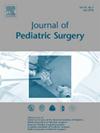儿童睾丸疼痛:近红外光谱不能鉴别诊断潜在的。
IF 2.5
2区 医学
Q1 PEDIATRICS
引用次数: 0
摘要
简介:目前尚无诊断睾丸扭转(TT)的快速检测方法。通过阴囊近红外光谱(NIRS)的有效性仍有待证明在儿童。在这里,我们测量了单侧TT儿童的睾丸氧合(StO2%),并将其与其他原因睾丸疼痛的儿童和对照组进行了比较。材料与方法:测定32例单侧睾丸疼痛男童(组1:有TT的19例,无TT的7例,有扭转扭转的6例)和对照组(组2:CG) 35例0 ~ 16岁健康男童的StO2%值。比较两组睾丸间StO2%的差异(配对或未配对的学生测试,或Wilcoxon和Mann-Whitney测试);结果:在CG中,右侧平均StO2%为74.2% (SD:15.5),左侧平均StO2%为73.4% (SD:14.0)。在TT组1中,TT侧平均StO2%为68.3% (SD:15.3),对侧为69.8% (SD:16.9)。两组间差异均无统计学意义(CG: 3.2% [SD:16.8], p= 0.6;第一组TT: -2.8% [SD:16.6], p=0.4)。对于没有TT的严重睾丸炎患者,两侧差异无显著性趋势(71.8% [SD:12.6] vs 82.8% [SD:14.6]; δ -14.8% [SD:18.5], p = 0.2)。结论:近红外光谱在临床上不适合诊断儿童TT。在对照组和TT受试者中,有或没有坏死,StO2%的值显示了广泛的个体内和个体间差异。炎症病理对StO2%的影响更大。证据水平:II。本文章由计算机程序翻译,如有差异,请以英文原文为准。
Testicular pain in children: Near-infrared spectroscopy cannot differentially diagnose underlying
Introduction
No rapid test to diagnose testicular torsion (TT) exists. The usefulness of trans-scrotal near-infrared spectroscopy (NIRS) remains to be proven in children. Here, we measured testicular oxygenation (StO2%) in children with unilateral TT and compared values to those measured in children with another cause of testicular pain and in control subjects.
Material and methods
StO2% values were measured in 32 boys with unilateral testicular pain (group 1: 19 with TT, 7 without TT, 6 with torsion-detorsion) and in a control group (group 2: CG) of 35 healthy boys, aged 0–16 years.
The difference in StO2% between the two testicles for the groups was compared (paired or unpaired Student's tests, or Wilcoxon and Mann–Whitney tests; p < 0.05).
Results
In the CG, the mean StO2% was 74.2 % (SD:15.5) on the right and 73.4 % (SD:14.0) on the left. In group 1 TT, the mean StO2% was 68.3 % (SD:15.3) on the TT side vs 69.8 % (SD:16.9) on the contralateral side. The difference between the two sides was not significant for either group (CG: 3.2 % [SD:16.8], p = 0.6; Group 1 TT: −2.8 % [SD:16.6], p = 0.4). For patients with severe testicular inflammation without TT, a non-significant trend for greater differences between sides was observed (71.8 % [SD:12.6] vs 82.8 % [SD:14.6]; Delta −14.8 % [SD:18.5], p = 0.2).
Conclusion
NIRS is not suitable to diagnose TT in children in clinical practice. StO2% values showed extensive intra- and inter-individual variability in both control and TT subjects, with or without necrosis. Inflammatory pathologies appear to have a greater impact on StO2%.
Level of evidence
II.
求助全文
通过发布文献求助,成功后即可免费获取论文全文。
去求助
来源期刊
CiteScore
1.10
自引率
12.50%
发文量
569
审稿时长
38 days
期刊介绍:
The journal presents original contributions as well as a complete international abstracts section and other special departments to provide the most current source of information and references in pediatric surgery. The journal is based on the need to improve the surgical care of infants and children, not only through advances in physiology, pathology and surgical techniques, but also by attention to the unique emotional and physical needs of the young patient.

 求助内容:
求助内容: 应助结果提醒方式:
应助结果提醒方式:


